BELFAST, Northern Ireland — In his home studio in Belfast, artist Glyn Smyth spends his days designing album covers, gig posters and other similar commissions, while working on his own pieces in the off-time. He is a full-time, professional printmaker, illustrator and graphic design artist with a wide range of styles from textile patterns and art nouveau to print illustrations depicting a haunting realism. Despite this artistic range, there is one particular element that does bind all of his work together, and that something is found through his deep devotion to esoteric themes.

“Savage Mistress”
“Although I don’t align myself to any one school of thought or tradition, my interest in Witchcraft seems deeply rooted on an emotional level. I do feel that many artists — and not necessarily just those who identify with the esoteric or occult — regularly invoke similar forces to those experienced by magical practitioners. My gut feeling is that to a great extent, magical thinking and practice is something universal, even if it manifests in a myriad of forms,” Smyth explained in an email interview with The Wild Hunt.
He further said, “Ultimately, I have an aversion to the concept of ‘religion’ which I tend to view as a control mechanism, but feel that the ‘New Atheism’ of the last few years is essentially throwing the baby out with the bath water. We’re dismissing millennia of shared cultural experiences and interactions with what appears to be another form of intelligence. On its most basic level, Witchcraft — regardless of what form it takes — seems to be a proactive way of interacting with these intelligences and that interests me greatly.”
Both Smyth’s artistic endeavors and his interest in the occult began at a very early age. He said that he can’t recall a time when he was not fascinated by either. As a child, Smyth was an avid drawer, picking up techniques very naturally. But, then in his teens, he drifted away from art due to a “dissatisfaction with [his] own efforts.”
But Smyth eventually returned to his roots in 2006, when friends began asking for his help with promotional material for their metal bands. “Graphic design would definitely be the bridge by which I returned to making art,” he said. “In older punk and metal culture, collage art was definitely a predominant aesthetic. Before Photoshop, we had scissors and glue and these were my weapons of choice for many years. The highly charged, political work by anarchist bands like Crass and pioneers such as John Heartfield are very important influences to me in this regard.”
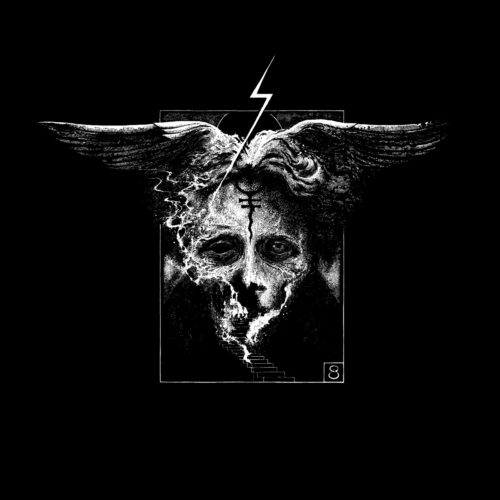
Commission for American metal band “Tombs”
He moved into printmaking, designing t-shirts and posters for his own band and others, eventually incorporating “illustrative” work. Smyth is now a full-time artist supporting his own studio. He said, “I’ve been freelance for over 10 years now, and whilst I still accept suitable commissions I am endeavouring to spend more of my time working on personal projects and printmaking from this point onwards. There is a distinct vision and aesthetic I have in mind for Stag & Serpent (my studio identity) and I’m keen to develop this more fully.”
Much of that identity is wrapped up in his personal interest in folklore and occult themes. He explained, “On one hand, it’s easy to say that subjects such as Witchcraft, mythology and other esoteric pursuits provide ample resources to draw from for visual art. This is undoubtedly true. But I am repeatedly drawn to similar types of imagery. Sometimes it’s a conscious decision, other times I realise there’s certain motifs and symbols that keep appearing without much pre-planning. Essentially, I feel that by drawing from these myths and engaging in an act of creation with them, I am helping myself to understand them more thoroughly.”
Within Smyth’s body of work, occult imagery and esoteric symbols can reveal themselves as tiny fragments embedded within a larger collage illustration, or as overarching themes breathing through the entire composition. Some of his work is purely symbolic in nature, such as in No Help for the Mighty Ones, and at other times the expression comes through in full illustration, such as in the Gathering.
Smyth imagery is dark and at times haunting, but it is equally evocative and empowering.
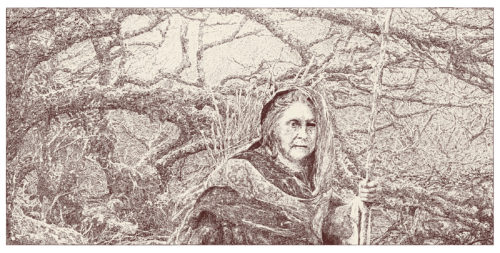
“The Gathering”
As noted earlier, many of Smyth’s prints are commissions for use as promotional material, including posters and album covers. He said, “I’m a long time fan of underground bands and I feel that this respect for these genres crosses over into the work. I take it seriously. The world of ‘metal’ is very diverse with a myriad of subgenres and aesthetic conventions in play, but I always strive to bring a fresh approach whilst acknowledging what’s come before.”
Although the term “metal” does cover a wide variety of sub-genres, he said, generally speaking, metal “does indeed seem to have a natural home with these [occult] themes.” This is idea is similar to that expressed in Peter Berbergal’s book Season of the Witch: How the Occult Saved Rock and Roll. Bebergal discusses “the remarkable influence occult beliefs have had on culture.” (Introduction, p. 28).
Smyth said, “The solemn and often experimental nature of many of the bands I work for echo the sentiments of past art movements. I feel that much Black Metal is essentially a modern incarnation of Romanticism in its basic themes and overall aesthetic, for example.” These sentiments often live at the crossroads of myth, magic, religion, and artistic expression.
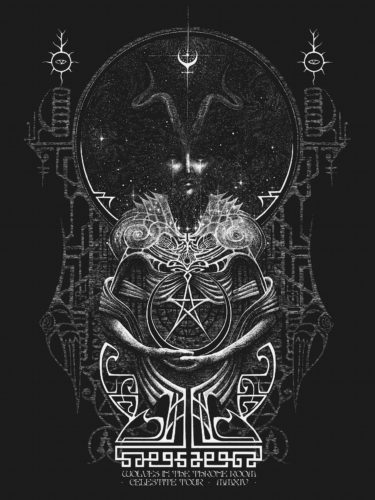
Commission for metal band “Wolves in the Throne Room”
When designing an album cover, Smyth doesn’t always have the new music available for inspiration. In those cases, he said, “I listen to the band’s earlier work at the outset to get a general feel for it. But more so than the sound of the band, it’s the ideas they want represented I rely on as a guide. I usually try to find some visual symbolism inherent in the concept, do some reading and let it stew for a while.”
He added, “I try not to force it, or let myself get coerced into too strict an approach. Keeping things malleable until the late stages seems the key to success in my experience. I like getting a good conceptual starting point and then being allowed to see where that takes me as opposed to having the specific visuals mapped out.”
Smyth approaches his own art in the same conceptual and spiritual way, saying that simply “appropriating symbols” is not the aim. He explained, “I prefer to succumb to the idea itself, rather than try and force it as such. On a conscious level I focus primarily on composition and technique, but also like to leave room for the idea to breathe and ‘do its own thing’ as such […] With my own personal work I’m inclined to leave the process much more open to suggestion from external sources, synchronicities and the like.”
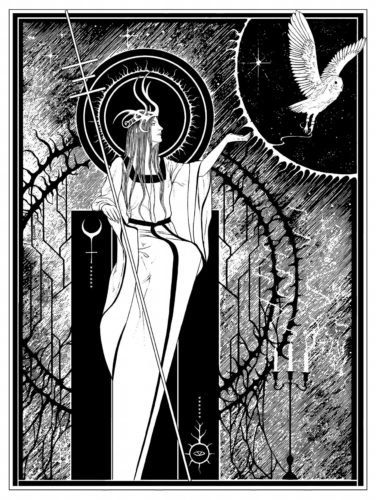
“Celestial”
While commercial illustration can often confine his exploration and limit the depth of expression, Smyth has been spending more time with his own work in recent years. Before 2013, Smyth operated under the name Scrawled Design, a moniker that he felt he had outgrown as he increasingly began to explore his own work beyond the band commissions. On Samhain 2014, he launched Stag & Serpent.
“It was a conscious move to reframe my illustration work more in line with my own personal interests whilst placing renewed emphasis on the pure “design” aspects of my work,” he said. “I also saw this as an opportunity to set myself some personal rules regarding aesthetics and the type of projects I wished to be involved in.”
When asked if he had any one piece that was particularly powerful for him, he first said, “I try not to dwell too much on work once it’s done and keep moving forward.” But he then added, “On a personal level, I’m very happy with my ‘Gathering’ print [shown earlier] which I just released. I feel I achieved the atmosphere I was going for here…which is not always the case. Over the last while I’ve tried to express more nuance and even ambiguity in my work. It’s the mystery that endures, not so much the answer I guess.”
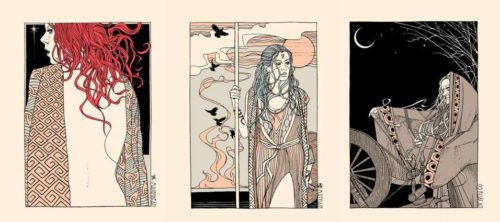
“Maiden, Mother, Crone” prints
As for the meaning behind the studio’s name, Smyth said, “Stag & Serpent is essentially a title that acknowledges duality in nature. Solar and cthonic. The serpent on the cross. Male and female polarities. These positions are not necessarily fixed. There’s a certain gnostic quality to the thinking here. The name and symbol design came very much out of the blue and I’m content to let the meaning evolve with time.”
Although Smyth’s aesthetic, working style, and personal interests are strongly centered in occult expression, he hasn’t illustrated much specifically for occult projects. He said, “I have been approached by a few esoteric publishers on the possibility of illustrating specific magical texts. Obviously I find this interesting and is something I would certainly consider if the timing and material was right.” Some of his work will be in the Pillars Vol. I : Perichoresis, to be published by Anathema Publishing in late 2016.
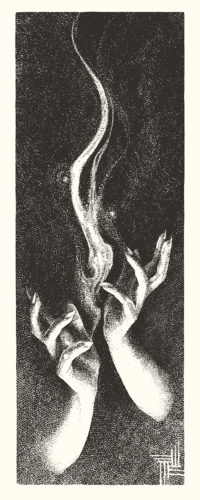
“Our Flame Returned” Smyth’s newest illustration not yet printed.
Smyth added, “a Tarot deck is definitely something I would like to work on some day. I could see this being quite a few years further down the line however.” That idea is not at all far reaching when looking through his gallery at many of pieces.
Right now, he said that he has a backlog of personal projects to work on, including one called the Shadows of the Fort, an “open-ended project which may also find outlets in the form of small publications or books.” He also continues to take commissions to help sustain his studio and freelance business. And, he sells his limited edition prints over the Internet through his studio site.
Smyth described his work and this new direction “a calling.” He said, “The material is both poetic and challenging, and invites different approaches and interpretations. It also allows me to embark on work that is directly related to the land around me which feels important after years of working with overseas clients.”
More of Glyn Smyth’s work is on display at his gallery, Stag & Serpent. The site also includes journal entries, which offer a further looks into his influences, as well as a video displaying his printmaking techniques.
“In retrospect,” said Smyth “I now at last feel I’m doing what I’m meant to be doing.”
NOTE: All images appearing in this article are the property of Glyn Smyth. They are copyright protected, and are not to be reproduced in any way without written permission from the artist. © 2016 Glyn Smyth. All Rights Reserved.
The Wild Hunt is not responsible for links to external content.
To join a conversation on this post:
Visit our The Wild Hunt subreddit! Point your favorite browser to https://www.reddit.com/r/The_Wild_Hunt_News/, then click “JOIN”. Make sure to click the bell, too, to be notified of new articles posted to our subreddit.
Fascinating.
The Spark of Inspiration shows again.
As an art student, I am very impressed with his talent. The artwork shown is indeed very inspiring and evocative. I am somewhat dismayed, however, to see the first piece of artwork entitled “Savage Mistress”. Haven’t women been denigrated enough over the centuries? Sigh